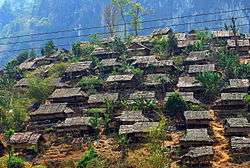Internal conflict in Myanmar
| Internal conflict in Myanmar | |||||||||
|---|---|---|---|---|---|---|---|---|---|
 Map of conflict areas in Myanmar (Burma). States and regions affected by fighting during and after 1995 are highlighted in yellow. | |||||||||
| |||||||||
| Belligerents | |||||||||
|
Former combatants:
|
Insurgent groups[note 1]
...and others Former combatants:
|
| |||||||
| Casualties and losses | |||||||||
|
130,000[28]–250,000[29] killed | |||||||||
The internal conflict in Myanmar (also known as Burma) refers to a series of ongoing insurgencies within Myanmar that began shortly after the country became independent from the United Kingdom in 1948. The conflict has been described as one of the world's "longest running civil wars".[31]
Background
Prior to independence from the United Kingdom, several anti-colonial groups in Myanmar (Burma) protested against British rule over the country. The groups became especially influential during World War II, when the Empire of Japan promised an "independent Burmese state" (restricted under the status of a puppet state under Japan), and appointed Ba Maw as its head of state.[32] During this period, left wing groups such as the Communist Party of Burma (also known as the Burma Communist Party) and ethnic insurgent groups such as the Karen National Union began to emerge in opposition to both the British and Japanese.[33] In 1947, the Panglong Agreement was reached between Aung San and ethnic leaders, in an attempt to quell hostilities; however, the agreement was not honoured by the post-independence government following Aung San's assassination, leading to further ethnic tensions and the eventual outbreak of ethnic conflicts.[34]
After Burmese independence in 1948, communists and ethnic minorities in the country began growing discontent against the newly formed post-independence government, as they believed that they were being unfairly excluded from governing the country.[2][32] For example, it was noted that many Christian Karen military officials, whom were originally appointed by the British, were replaced with Buddhist Bamars by the new parliament. In the early 1960s, the government refused to adopt a federal system, to the dismay of insurgent groups such as the CPB, who proposed adopting the system during peace talks. By the early 1980s, politically motivated armed insurgencies had largely disappeared, while ethnic-based insurgencies continued.
Several insurgent groups have negotiated ceasefires and peace agreements with successive governments, which until political reforms that begun in 2011 and ended in 2015, had largely fallen apart.[31][35]
Timeline
The conflict is generally divided into three parts: Insurgencies during the post-independence period under parliamentary rule (1948–1962), insurgencies during post 1962 coup military rule under General Ne Win during the Cold War (1962–1988), and insurgencies during the modern post Cold War era, first under military (Tatmadaw) rule (1988–2011), and now currently under the new elected government.
Post-independence conflict (1948–1962)
Following independence, the two largest insurgent factions in Myanmar (Burma) were the communists, led by the Communist Party of Burma (CPB), and ethnic Karen insurgents, led by the Karen National Union (KNU). Both groups had fought the British colonial government prior to independence, and had also fought Japanese forces during their occupation in World War II.[32] Within eight months of independence, several other ethnic insurgent groups were formed, such as the Pa-O National Army.[36]
During the post-independence period, the KNU favoured an independent state, administered by the Karen people. The proposed state would be forged out of Kayin and Kayah State (Karen and Karenni State), in Outer Myanmar (Lower Burma). The KNU has since shifted their focus from full independence to regional autonomy, under a federal system with fair Karen representation in the government.[37]
Post-coup conflict (1962–1988)

After three successive parliamentary governments governed Myanmar (Burma), the Tatmadaw (Myanmar Armed Forces), led by General Ne Win, enacted a coup d'état in 1962, which ousted the parliamentary government, and replaced it with a military junta. Accusations of severe human rights abuses and violations followed afterwards, and the cabinet of the parliamentary government and political leaders of ethnic minority groups were arrested and detained without trial.[25] Around this period, other ethnic minority groups began forming larger rebel factions, such as the Kachin Independence Army, in response to the new government's refusal to adopt a federal government structure.
Both immediately after the coup and again in 1972, General Ne Win held peace talks with opposition forces, but both times they fell apart, partly due to General Ne Win's refusal to adopt a multi-party system. After negotiations failed, defectors from the Tatmadaw and ethnic insurgents walked back to their bases, with headlines across Myanmar famously reading "They Go Back" (သူတို့ပြန်ကြလေပြီ). Private property was confiscated by the government, and the Burmese Socialist Programme Party (BSPP) was founded in 1974 to govern the country under a one-party system. Under General Ne Win's 26 year dictatorship, Myanmar became an isolated hermit kingdom, and became one of the least developed countries in the world. In 1988, nationwide student protests resulted in the BSPP and General Ne Win being ousted and replaced with a new military regime, the State Peace and Development Council.[26]
8888 Uprising
On 8 August 1988, students began demonstrating in Rangoon (Yangon) against General Ne Win's rule, and the disastrous Burmese Way to Socialism system. The protests spread across the country,[38] The uprising ended on 18 September 1988, after a military coup was enacted by the State Law and Order Restoration Council (SLORC), and Ne Win was overthrown.
Authorities in Myanmar (Burma) claimed that around 350 people were killed,[39][40] whilst anti-government groups claimed thousands died in the protests, with a high number of deaths attributed to the military.[41][42][43] According to the Economist, over 3,000 people were killed in the public uprising.[44] As a result of the uprising, the new government agreed to sign separate peace treaties with certain insurgent groups. Because the 1988 uprising was mostly politically motivated, ethnic insurgent groups did not receive much support from political movements in Myanmar. In the 1990s, the Tatmadaw severely weakened ethnic insurgent groups, destroying most of their bases and strongholds.
Post-Cold War conflict (1988–present)
In 2006, the Tatmadaw (Myanmar Armed Forces) conducted a large offensive against the Karen National Union (KNU) in Kayin State, which resulted in the displacement of hundreds of thousands of civilians. One estimate claimed that approximately half a million people were displaced due to fighting between government forces and the KNU, and forcible relocation of villages by the government.[45][46]
In 2011, the Tatmadaw launched a military offensive named Operation Perseverance (ဇွဲမန်ဟိန်း) against insurgents in Shan State.[47] During the offensive, the Tatmadaw captured territory from the National Democratic Alliance Army (NDAA) and the Shan State Army - North (SSA-N), with the SSA-N being involved in most of the fighting. The offensive was in response to the groups' rejections of the junta's "One Nation, One Army" policy.[48][49][50][51][52][53]
On 19 November 2014, government forces attacked the Kachin Independence Army's headquarters near the city of Laiza, killing at least 22 KIA insurgents, according to the government.[54]
Between February and May 2015, government forces launched several military operations in Kokang, in northern Shan State;[55] in response to attempts by the Myanmar National Democratic Alliance Army (MNDAA) to retake territory it had lost in 2009.[56]
On 9 October 2016, unidentified insurgents attacked border posts on the Myanmar-Bangladesh border, killing nine border officers.[57] Clashes continued, and on 11 October 2016, four Tatmadaw soldiers were killed by insurgents with recently looted weapons.[58]
Main fronts
Kachin State
The Kachin people are a major ethnic minority in Myanmar who mainly inhabit the mountainous northern regions of the Kachin Hills in Kachin State. They have fought for the self-determination of their people since Myanmar gained independence, though less so than other ethnic minorities in Myanmar, such as the Karen people. Kachin regular soldiers previously formed a significant part of the Myanmar military; however, after General Ne Win's regime seized power in 1962, many Kachin soldiers defected from the military and reorganized with already active Kachin insurgents to form the Kachin Independence Army (KIA), under the Kachin Independence Organisation (KIO). Religious tensions have also been a source of conflict, as Kachin people have historically been predominantly Christian, while the majority Bamar people have been predominantly Buddhist.[59]
Ceasefire agreements have been signed between the KIA and the government several times; most notably a ceasefire signed in 1994, that lasted for 17 years until June 2011, when government forces attacked KIA positions along the Taping River, east of Bhamo, Kachin State.[60]
In 2012 alone, fighting between the KIA and the government resulted in around 2,500 casualties (both civilian and military); 211 of whom were government soldiers. The violence resulted in the displacement of nearly 100,000 civilians, and the complete or partial abandonment of 364 villages.[61][62][63][64]
Kayah State
The largest insurgent group in Kayah State (also known as Karenni State) is the Karenni Army, whose goal for the past few decades has been to obtain independence and self-determination for the Karenni people.[65]
The group has claimed that their grievances towards the government include: the (government's) exploitation and rapid depletion of the natural resources in the region, the forced sale of farmer's agricultural products for low prices, extortion and corruption within local authorities, forced labour, forced relocation of whole villages and farms, destruction of houses, planting of mines in civilian areas, torture, rape, extrajudicial killings, burning of villages, expropriation of food supplies and livestock, arrests without charge, and exploitation of the poor. The Karenni Army is currently led by General Bee Htoo,[65] and consists of roughly between 500[13] and 1,500 soldiers.[17]
Kayin State
The Karen people of Kayin State (also known as Karen State) in eastern Myanmar are the third largest ethnic group in Myanmar, consisting of 7% of the country's total population, and have fought for independence and self-determination since 1949. In 1949, the commander-in-chief of the Tatmadaw General Smith Dun, an ethnic Karen, was fired and replaced by Ne Win, a Bamar nationalist who would go on to become the dictator of Myanmar, because of the rise of Karen opposition groups.[36]
The initial aim of the largest Karen opposition group, the Karen National Union (KNU), and its armed wing, the Karen National Liberation Army (KNLA), was to obtain independence for the Karen people. However, since 1976 they have instead called for a federal union with fair Karen representation, and the self-determination of the Karen people.[37] Nearly all of their demands and requests have been ignored or denied by successive governments, a contributing factor to failed peace talks until political reforms which begun in 2011 and ended in 2015.
In 1995, the main headquarters and operating bases of the KNU had mostly been destroyed or captured by the government, forcing the KNLA (the armed wing of the KNU) to instead operate in the jungles of Kayin State. Up until that year, the Thai government had been supporting insurgents across its border, but soon stopped its support due to a new major economic deal with Myanmar.[2]
The government of Myanmar has been accused of using "scorched earth" tactics against Karen civilians in the past, including (but not limited to) burning down entire villages, planting land mines, using civilians as slave labour, using civilians as minesweepers, and the rape and murder of Karen women.[66] According to a report by legal firm DLA Piper, whose report was presented to the United Nations Security Council, these tactics against the Karen can be identified as ethnic cleansing. The government had however, denied these claims.[67]
Rakhine State
Insurgent groups of the Chin, Rakhine (also known as Arakanese), and Rohingya ethnic minorities have fought against the government for self-determination in Rakhine State since the early 1950s.[68][69][70]
Rakhine insurgent groups, such as the Arakan Army and Arakan Liberation Army (ALA) continue to have hostilities towards the government, though major violence has been rare since political reforms and peace talks. The Arakan Army, founded in 2009, is currently the largest insurgent group in Rakhine State, with 1,500–2,500 fighters active in the region.[71]
Insurgents of the Rohingya ethnic minority have been fighting local government forces and other insurgent groups in northern Rakhine State since 1948, with ongoing religious violence between the predominantly Muslim Rohingyas and Buddhist Rakhines fueling the conflict. The legal and political rights of the Rohingya people have been an underlying issue in the conflict, with spontaneous bouts of violence such as the 2012 Rakhine State riots and 2013 Myanmar anti-Muslim riots periodically occurring as a result. Despite making up a majority of the population in the three northern townships of Rakhine State,[70] Rohingyas are often targets of religiously motivated attacks. Because the government does not recognise the Rohingya people as an official ethnic group in Myanmar, Rohingyas cannot apply for citizenship, and few laws exist to protect their rights.[72]
On 9 October 2016, an estimated 300 unidentified insurgents attacked three Burmese border posts along Myanmar's border with Bangladesh. According to government officials in the border town of Maungdaw, the attackers looted several dozen firearms and ammunition from the border posts, and brandished knives and homemade slingshots that fired metal bolts. The attacks left nine border officers and "several insurgents" dead.[57] On 11 October 2016, four Tatmadaw soldiers were killed on the third day of fighting.[58] Though it is not known who the perpetrators were, government officials in Rakhine State have blamed the Rohingya Solidarity Organisation (RSO), an insurgent group that was mainly active in the 1980s and 1990s and had foreign Islamist backers, whilst others pointed to terrorist groups from Bangladesh.[73]
Shan State
The Shan people are the largest ethnic group in Shan State, and the second largest in Myanmar. In 1947, the Panglong Agreement was negotiated between Aung San, a prominent founding father of Myanmar, and Shan leaders, which would have given the Shan the option to split from Myanmar a decade after independence if they were unsatisfied with the central government.[34] This was, however, not honoured by the post-independence government following Aung San's assassination.[6] During the Tatmadaw's (Myanmar Armed Forces') heavy militarisation of the state in the late 1940s and early 1950s, locals accused them of mistreating, torturing, robbing, raping, unlawfully arresting, and massacring villagers. As a result, on 21 May 1958, an armed resistance movement, led by Sao Noi and Saw Yanna, was started in Shan State.
One the largest Shan insurgent groups in Myanmar is the Shan State Army - South (SSA-S), which has around 6,000 to 8,000 soldiers, and was led by Yawd Serk until his resignation on 2 February 2014. The SSA-S maintains bases along the Myanmar-Thailand border, and signed a ceasefire agreement with the government on 2 December 2011.[74]
Political discontent
Prior to independence, Aung San, considered a founding father of Myanmar, had convinced local Shan leaders to join him in his pursuit for independence, and with them, negotiated the Panglong Agreement in 1947. The agreement guaranteed the right to self-determination, political representation in the post-independence government, and economic equality amongst the various ethnic groups. It also gave the Chin, Kachin, and Shan people the option to separate from Myanmar after a decade if their states' leaders were unhappy with the central government. However, this was not honored by the government, and has been one of the causes of insurgencies in those states.[6]
Whilst some groups continue to fight for full independence and for the right for self-determination of their people, groups such as the Chin National Front (CNF) and the Karen National Union (KNU) have since fought instead for regional autonomy, and a federal system of government in Myanmar.[75]
During the 1988 uprising, Aung San Suu Kyi emerged as a national symbol for democracy, after leading the largest opposition party, the National League for Democracy (NLD). The military junta arranged a general election in 1990 and Aung San Suu Kyi's party, the National League for Democracy (NLD) won a majority of the vote. However, the military junta refused to recognise the results and instead placed Aung San Suu Kyi under house arrest for 15 years.
In 2007, hundreds of thousands of monks protested against the military junta's rule, and called for free elections, minority rights and the release of political prisoners in an event now known as the Saffron Revolution.[76] The protest originally began in response to the government's removal of price subsidies for compressed natural gas.[77]
Aung Sun Su Kyi had been silenced by the military government, put under house arrest, and had been struggling to run in the country's elections for several years. In 2011, the government introduced a new constitution following political reforms, and thousands of political prisoners were released, including Aung San Su Kyi. In November 2014, the NLD attempted to make amendments to the constitution, in response to a clause that made Aung San Suu Kyi ineligible to become President of Myanmar if her party won an election. These amendments however, were rejected.[78]
Human rights violations
The government of Myanmar has been accused of using "scorched earth" tactics against civilians, most notably in Kayin State. The accusations included burning down entire villages, planting landmines, using civilians as slave labour, using civilians as minesweepers, and the rape and murder of Karen women.[66] According to a report by legal firm DLA Piper, whose report was presented to the United Nations Security Council, these tactics against the Karen have been identified as ethnic cleansing.[67]
Both sides have been accused of using landmines, which have caused hundreds of accidental civilian injuries and deaths. The Karen National Union (KNU) has been accused of planting landmines in rural areas, most of which have not been disarmed. The KNU claim that landmines are vital to repelling government forces, because it "discourages them from attacking civilians". However, a majority of those who fall victim to KNU planted landmines are local villagers, rather than government soldiers.[79] Victims of landmines must travel to the Thai-Myanmar border to seek treatment, as local hospitals and facilities lack proper equipment and funding.[80]
Both sides have also been accused of using thousands of child soldiers, despite the fact that the government of Myanmar and seven insurgent groups signed an agreement with UNICEF in 2012, promising not to exploit children for military and political gains. The International Labor Organization (ILO) has accused both sides of continuing to use child soldiers despite the agreement. According to the ILO, the Tatmadaw have discharged hundreds of child soldiers since 2012; however, they estimated that at least 340 child soldiers had been recruited by the Tatmadaw between 2013 and 2014.[81] The most notable case of the use child soldiers in Myanmar was of Johnny and Luther Htoo, the leaders of God's Army, a former rebel faction. At the time of their formation of God's Army, they were both only 10 years old.[82]
Refugee crisis
The conflict has resulted in a large number of both civilian deaths and refugees, with many refugees fleeing to Thailand. The UN estimates that between 1996 and 2006, around 1 million people were displaced inside Myanmar, and that over 230,000 people remain displaced in Southeast Myanmar, and 128,000 refugees live in temporary shelters on the Thai-Myanmar border.[84][85] In August 2007, approximately 160,000 refugees fled to nine refugee camps along the Thai-Myanmar border, and the Thai border provinces of Chiang Mai and Ratchaburi. Approximately 62% of the refugee population consisted of people from the Karen ethnic minority. Humanitarian organisations such as Doctors Without Borders have since sent assistance and support to the refugees.[86]
Civilians have allegedly been removed from their homes and have had their land confiscated by the government to be used in industrial projects.[84][87] Civilians have also been removed from their homes by the central government, and their land confiscated, in order for development projects and resource exploitation.[87][88]
In Rakhine State, there are currently about 75,000 Rohingya refugees, according to Refugee International.[89] UNICEF has reported that living conditions in Rohingya refugee camps in Rakhine State are "wholly inadequate" and lacks access to basic services.[90] Historically, the persecution of Burmese Indians and other ethnic minority groups in Myanmar after the 1962 coup has led to the expulsion of nearly 300,000 people.[91] More than 200,000 Rohingya Muslims have fled to Bangladesh over the last 20 years to escape persecution.[92] The Rohingya people have been described by the United Nations as "among the world's least wanted" and "one of the world's most persecuted minorities."[93] Al-Qaeda leader Ayman Al-Zawahiri has also threatened Myanmar with terrorist attacks, after their "terror network" expanded into India, Bangladesh and Myanmar.[94]
International responses
![]() United Nations: Since 1991, the UN General Assembly has adopted twenty five UN resolutions regarding Myanmar's government, condemning previous military juntas for their systematic violations of human rights and lack of political freedom.[95] In 2009 they urged the then ruling junta to take urgent measures to end violations of international human rights and humanitarian laws in the country.[96] The request was mostly honoured during political reforms that begun in 2011 and ended in 2015. According to research from Harvard University’s International Human Rights Clinic (IHRC), three government officials have committed war crimes and crimes against humanity in southeast Myanmar under a previous military regime.[97]
United Nations: Since 1991, the UN General Assembly has adopted twenty five UN resolutions regarding Myanmar's government, condemning previous military juntas for their systematic violations of human rights and lack of political freedom.[95] In 2009 they urged the then ruling junta to take urgent measures to end violations of international human rights and humanitarian laws in the country.[96] The request was mostly honoured during political reforms that begun in 2011 and ended in 2015. According to research from Harvard University’s International Human Rights Clinic (IHRC), three government officials have committed war crimes and crimes against humanity in southeast Myanmar under a previous military regime.[97]
Foreign support
![]() China – The People's Republic of China allegedly supported the Communist Party of Burma until its dissolution in 1989, and have recently been accused of supporting insurgent groups across its border with Myanmar such as the United Wa State Army.[5]
China – The People's Republic of China allegedly supported the Communist Party of Burma until its dissolution in 1989, and have recently been accused of supporting insurgent groups across its border with Myanmar such as the United Wa State Army.[5]
![]() Thailand – Thailand had been a vocal supporter of various insurgent groups in Myanmar, and allowed weapons and ammunition to be smuggled through Thailand into Myanmar through lax enforcing of its border.[3] However, in 1995 the Thai government secured its border with Myanmar and stopped all logistical support going through Thailand after they signed a major economic deal with Myanmar.[2]
Thailand – Thailand had been a vocal supporter of various insurgent groups in Myanmar, and allowed weapons and ammunition to be smuggled through Thailand into Myanmar through lax enforcing of its border.[3] However, in 1995 the Thai government secured its border with Myanmar and stopped all logistical support going through Thailand after they signed a major economic deal with Myanmar.[2]
Others: Dave Everett was a member of the Australian Special Air Service Regiment before leaving in 1986 and joining the Karen National Liberation Army (KNLA) as a mercenary. Everett fought alongside the KNLA under the alias "Steve" and trained insurgents, helping them improve their marksmanship and teaching them how to use claymore anti-personnel mines. In order to fund his time with the KNLA, Everett perpetrated several robberies in Australia with the help of accomplices and took piloting lessons so he could smuggle weapons into Myanmar. Everett returned to Australia a year later in 1987.[10][Videos 1]
Ceasefire negotiations
Under the new constitutional reforms in 2011, state level and union level ceasefire agreements were made with many rebel factions. 14 out of 17 of the largest rebel factions signed a ceasefire agreement with the new reformed government. According to the Myanmar Peace Monitoring group, clashes between Kachin Independence Organisation (KIO), its allies, and the government, has displaced hundreds of thousands of people, and create another severe humanitarian crisis in Kachin and northern Shan State.[98] All of the 14 signatories wanted negotiations in accordance with the Panglong Agreement of 1947, which granted self-determination, a federal system of government (meaning regionol autonomy), religious freedom, and ethnic minority rights. However, the new constitution, only had a few clauses dedicated to minority rights, and therefore, the government discussed with rebel factions using the new constitution for reference, rather than the Panglong Agreement. There was no inclusive plan or body that represented all the factions, and as a result, in resent, the KNU backed out of the conference and complained the lack of independence for each party within the ethnic bloc.[99] However, most of the negotiations between the State Peace Deal Commission and rebel factions were formal and peaceful.[100]
In April 2015, a draft Nationwide Ceasefire Agreement was finalised between representatives from fifteen different insurgent groups (all part of the Nationwide Ceasefire Coordination Team or NCCT), and the Government of Myanmar.[101]
In October 2015, after two years of negotiations, the government of Myanmar announced that it will finalise and sign a ceasefire agreement with eight insurgent groups, including the Karen National Union. However, only 8 out of the 15 original signatories signed the ceasefire agreement on 15 October 2015, after seven of members of the NCCT backed out of negotiations in September 2015. The signing was witnessed by observers and delegates from the United Nations, the United Kingdom, Norway, Japan, and the United States.[45][46]
See also
Notes
- ↑ Only groups with significant numbers or recent activity is shown. For a full list see here.
- ↑ The CIA aided Kuomintang soldiers fleeing from communist forces in Myanmar through Operation Paper, supplying them with non-lethal aid via Thailand until 1953, when they airlifted 7,000 soldiers back to Taiwan and stopped the operation.[4][5]</ref>
Commanders and leaders
 Htin Kyaw
Htin Kyaw
(President of Myanmar)
 Sein Win
Sein Win
(Minister of Defence)

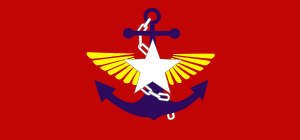 Min Aung Hlaing
Min Aung Hlaing
(Commander-in-Chief)

 Soe Win
Soe Win
(Deputy Commander-in-Chief)Former commanders:-
.svg.png) Sao Shwe Thaik (1948–1952)
Sao Shwe Thaik (1948–1952)
-
.svg.png) U Nu (1948–1962)
U Nu (1948–1962)
-
.svg.png) Ba U (1952–1957)
Ba U (1952–1957)
-
.svg.png) Win Maung (1957–1962)
Win Maung (1957–1962)
-
.svg.png) Ne Win (1962–1981)
Ne Win (1962–1981)
-
.svg.png) San Yu (1981–1988)
San Yu (1981–1988)
-
.svg.png) Saw Maung (1988–1992)
Saw Maung (1988–1992)
-
.svg.png) Than Shwe (1992–2011)
Than Shwe (1992–2011)
-
 Wai Lwin (2011–2015)
Wai Lwin (2011–2015)
-
 Thein Sein (2011–2016)
Thein Sein (2011–2016)
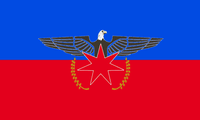 Twan Mrat Naing
Twan Mrat Naing
 Naw Zipporah Sein
Naw Zipporah Sein
 Saw Mutu Say Poe
Saw Mutu Say Poe
 Pheung Kya-shin
Pheung Kya-shin
 Yang Mao-liang
Yang Mao-liang
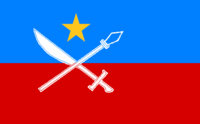 Bao Youxiang
Bao Youxiang
 Wei Hsueh-kang
Units involvedFormer commanders:
Wei Hsueh-kang
Units involvedFormer commanders:-
.png) Thein Pe Myint (1948–52)
Thein Pe Myint (1948–52)
-
_and_(1946-1970).svg.png) Thakin Soe (POW) (1948–70)
Thakin Soe (POW) (1948–70)
-
 Saw Ba U Gyi † (1949–1950)
Saw Ba U Gyi † (1949–1950)
-
.png) Thakin Than Tun † (1952–68)
Thakin Than Tun † (1952–68)
-
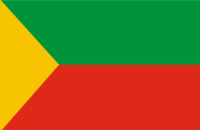 Lo Hsing Han (POW) (1967–1973)
Lo Hsing Han (POW) (1967–1973)
-
 Bo Mya (1976–2000)
Bo Mya (1976–2000)
-
 Khun Sa
Khun Sa  (1985–1996)
(1985–1996)
-
 Bo Nat Khann Mway (1994–2016)
Bo Nat Khann Mway (1994–2016)
-
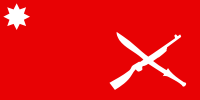 Yawd Serk (1996–2014)
Yawd Serk (1996–2014)
- Johnny and Luther Htoo
 (1997–2006)
(1997–2006)
-
 Pado Phan (2000–2008)
Pado Phan (2000–2008)
 Tatmadaw
Strength
Tatmadaw
Strength
 492,000[note 3]
492,000[note 3] -
- ↑ Number shown includes personnel not directly involved in the conflict. There are also an additional 72,000 reserve personnel.<ref>International Institute for Strategic Studies; Hackett, James (ed.) (2010). The Military Balance 2010. London: Routledge, pp. 420-421. ISBN 1-85743-557-5.
References
- 1 2 3 4 Richard Michael Gibson (2011). The Secret Army: Chiang Kai-shek and the Drug Warlords of the Golden Triangle. John Wiley and Sons. p. 88. ISBN 978-0-470-83018-5.
- 1 2 3 4 Lintner, Bertil. "Recent Developments on Thai-Myanmar Border. IBRU Boundary and Security Bulletin": 72.
- 1 2 Alfred W. McCoy, with Cathleen B. Read and Leonard P. Adams II. "The Shan Rebellion: The Road to Chaos", from The Politics of Heroin in Southeast Asia: CIA Complicity in the Global Drug Trade (2003 ed.). Lawrence Hill Books. ISBN 1-55652-483-8. Archived from the original on 23 September 2011. Retrieved 8 December 2011.
- 1 2 Richard Michael Gibson (2011). The Secret Army: Chiang Kai-shek and the Drug Warlords of the Golden Triangle. John Wiley and Sons. pp. 85–90. ISBN 978-0-470-83018-5.
- 1 2 3 Steinberg, p. 44
- 1 2 3 4 U Thant Myint (2006). The River of Lost Footsteps - Histories of Burma. Farrar, Straus and Giroux. pp. 274–289. ISBN 978-0-374-16342-6.
- ↑ CNN, Katie Hunt. "Myanmar Air Force helicopters fire on armed villagers in Rakhine state". CNN. Retrieved 15 November 2016.
- ↑ "Border Guard Force Scheme". www.mmpeacemonitor.org. Myanmar Peace Monitor. Retrieved 8 May 2016.
- 1 2 3 4 5 6 "Armed ethnic groups". Myanmar Peace Monitor. Retrieved 2016-01-29.
- 1 2 "Cookies must be enabled. | The Australian". theaustralian.com.au. Retrieved 21 October 2015.
- ↑ Heppner & Becker, 2002: 18–19
- ↑ "ABSDF". Myanmar Peace Monitor. Retrieved 2016-01-29.
- 1 2 3 4 I. Rotberg, Robert (1998). Burma: Prospects for a Democratic Future. Brookings Institution Press. ISBN 0815791690.
- ↑ "'I Want to Stress That We Are Not the Enemy'". Retrieved 28 September 2015.
- ↑ "DKBA-5". Myanmar Peace Monitor. Retrieved 2016-01-29.
- ↑ AP, 4 May 2012, Myanmar state media report battles between government troops, Kachin rebels killed 31
- 1 2 3 4 Burma center for Ethnic Studies, Jan. 2012, "Briefing Paper No. 1" http://www.burmalibrary.org/docs13/BCES-BP-01-ceasefires(en).pdf
- ↑ "NMSP". Myanmar Peace Monitor. Retrieved 2016-01-29.
- ↑ "47 Govt Troops Killed, Tens of Thousands Flee Heavy Fighting in Shan State". irrawaddy.org.
- ↑ "NDAA". Myanmar Peace Monitor. Retrieved 2016-02-28.
- ↑ "TNLA". Myanmar Peace Monitor. Retrieved 2016-01-29.
- ↑ Larsen, Niels (23 April 2015). "On Patrol With Myanmar Rebels Fighting Both the Army and Drug Addiction - VICE News". VICE News (Crime and Drugs).
- ↑ Johnson, Tim (29 August 2009). China Urges Burma to Bridle Ethnic Militia Uprising at Border. The Washington Post.
- ↑ Davis, Anthony. "Wa army fielding new Chinese artillery, ATGMs". IHS Jane's Defence Weekly. Retrieved 23 July 2015.
- 1 2 Pavković, 2011: 476
- 1 2 Lintner, Bertil (1999). Burma in revolt: opium and insurgency since 1948 (2nd ed. ed.). Chiang Mai: Silkworm Books. ISBN 978-974-7100-78-5.
- ↑ "Armed forces - Myanmar". www.nationsencyclopedia.com. Encyclopedia of the Nations.
- ↑ "Modern Conflicts - Death Tolls PDF" (PDF).
- ↑ "De re militari: muertos en Guerras, Dictaduras y Genocidios". Retrieved 6 October 2014.
- ↑ Janie Hampton (2012). Internally Displaced People: A Global Survey. London: Routledge. ISBN 978-1-136-54705-8.
- 1 2 Patrick Winn (13 May 2012). "Myanmar: ending the world's longest-running civil war". Pittsburgh Post-Gazette. Retrieved 27 March 2013.
- 1 2 3 Hensengerth, Oliver (2005). The Burmese Communist Party and the State-to-State Relations between China and Burma (PDF). Leeds East Asia Papers. pp. 10–12, 15–16, 17.
- ↑ Allen, Louis (1986). Burma: the Longest War 1941-45. Great Britain: J.M. Dent and Sons. ISBN 0-460-02474-4.
- 1 2 MAUNG ZARNI (19 July 2013). "Remembering the martyrs and their hopes for Burma". DVB NEWS. Retrieved 27 December 2013.
- ↑ Licklider, R. (1995). The Consequences of Negotiated Settlements in Civil Wars, 1945–1993. The American Political Science Review, 89(3), 681.
- 1 2 Smith, Martin (1991). Burma : insurgency and the politics of ethnicity (2. impr. ed.). London: Zed Books. ISBN 0862328683.
- 1 2 "About | Official Karen National Union Webpage".
- ↑ Maureen Aung-Thwin (1989). "Burmese Days". Foreign Affairs. Council on Foreign Relations, Inc. Retrieved 27 March 2013.
- ↑ Ottawa Citizen. 24 September 1988. pg. A.16
- ↑ Associated Press. Chicago Tribune. 26 September 1988
- ↑ Ferrara (2003), pp. 313
- ↑ Philippa Fogarty (6 August 2008). "Was Burma's 1988 uprising worth it?". BBC News. Retrieved 27 March 2013.
- ↑ Wintle (2007)
- ↑ "The saffron revolution | The Economist". web.archive.org. Retrieved 21 October 2015.
- 1 2 "Asia Unbound » Myanmar's Cease-Fire Deal Comes up Short". web.archive.org. Retrieved 21 October 2015.
- 1 2 Ray Pagnucco and Jennifer Peters (15 October 2015). "Myanmar's National Ceasefire Agreement isn't all that national". Vice News. Retrieved 18 October 2015.
- ↑ Htwe, Ko (8 April 2011). "Conflict in Shan State Spreading". The Irrawaddy. Archived from the original on 15 June 2011. Retrieved 16 July 2011.
- ↑ "Shan Herald Agency for News (S.H.A.N.)". Shanland.org. Retrieved 14 January 2012.
- ↑ Hseng, Khio Fah (10 January 2011). "Mongla base shelled by Burma Army artillery". Shan Herald Agency. Archived from the original on 17 January 2011. Retrieved 16 July 2011.
- ↑ Hseng, Khio Fah (26 January 2011). "Mongla base shelled by Burma Army artillery". Shan Herald Agency. Archived from the original on 28 January 2011. Retrieved 16 July 2011.
- ↑ "All roads to Shan rebel base closed". Shanland.org. 24 February 2011. Archived from the original on 30 September 2011. Retrieved 14 January 2012.
- ↑ "Burma Army occupies SSA core base". Shanland.org. 16 March 2011. Archived from the original on 30 September 2011. Retrieved 14 January 2012.
- ↑ "SSA 'North' given ultimatum to surrender". Shanland.org. 17 March 2011. Archived from the original on 30 September 2011. Retrieved 14 January 2012.
- ↑ "Myanmar's Kachin Rebels Say 22 Dead in Fighting". 19 November 2014. Retrieved 29 November 2014.
- ↑ "Myanmar Kokang Rebels Deny Receiving Chinese Weapons". Radio Free Asia.
- ↑ NANG MYA NADI (10 February 2015). "Kokang enlist allies' help in fight against Burma army". dvb.no.
- 1 2 "Myanmar policemen killed in Rakhine border attack". BBC News. 9 October 2016. Retrieved 12 October 2016.
- 1 2 "Rakhine unrest leaves four Myanmar soldiers dead". BBC News. 12 October 2016. Retrieved 13 October 2016.
- ↑ Fuller, T. (4 April 2013). "Ethnic Rifts Strain Myanmar as It Moves Toward Democracy". The New York Times.
- ↑ "Untold Miseries" (PDF). Hrw.org. Retrieved 19 February 2015.
- ↑ KIA claims 211 Tatmadaw soldiers have died in two months of fighting in Hpakant, 10 October 2012, http://www.kachinnews.com/news/2418-kia-says-211-army-soldiers-die-in-two-month-fighting-in-hpakant.html
- ↑ 31 dead in new clashes with Kachin: Myanmar News, 5 May 2012, http://dailytimes.com.pk/default.asp?page=2012\05\05\story_5-5-2012_pg14_7
- ↑ Lanjouw, S., Mortimer, G., & Bamforth, V. (2000). Internal Displacement in Burma. Disasters, 24(3), 228-239.
- ↑ "Kachin Women's Association Thailand - State terror in the Kachin hills". Kachinwomen.com. Archived from the original on 19 February 2015. Retrieved 19 February 2015.
- 1 2 Karenni Army (KA) (Myanmar), GROUPS - ASIA - ACTIVE, Jane's World Insurgency and Terrorism, 13 March 2012
- 1 2 Phan, Zoya and Damien Lewis. Undaunted: My Struggle for Freedom and Survival in Burma. New York: Free Press, 2010.
- 1 2 Gray Cary, Rudnick (2005). "Threat to the Peace: A Call for the UN Security Council to Act in Burma" (PDF). DLA Piper. Retrieved 10 April 2016.
- ↑ "Myanmar Peace Monitor - Chin National Front".
- ↑ "Myanmar Peace Monitor - Arakan Liberation Party".
- 1 2 "Myanmar, Bangladesh leaders 'to discuss Rohingya'". Agence France-Presse. 29 June 2012.
- ↑ "Arakan Army Official Website".
- ↑ MclaughLin, Tim (8 July 2013). "Origin of 'most persecuted minority' statement unclear". Retrieved 17 February 2015.
- ↑ "Myanmar: Fears of violence after deadly border attack". www.aljazeera.com. Retrieved 13 October 2016.
- ↑ "Myanmar Peace Monitor - Restoration Council of Shan State".
- ↑ "Karen National Union Website - English".
- ↑ "Human Rights Concern". Archived from the original on 16 May 2009. Retrieved 7 April 2009.
- ↑ "BBC NEWS | World | Asia-Pacific | Burma leaders double fuel prices". news.bbc.co.uk. Retrieved 16 May 2015.
- ↑ Landler, M. (14 November 2014). Obama and Aung San Suu Kyi Meet Again, With Battle Scars. Retrieved 24 November 2014, from http://www.nytimes.com/2014/11/15/world/asia/obama-aung-san-suu-kyi-myanmar.html?_r=0
- ↑ The world's longest ongoing war. 13 August 2011 – via YouTube.
- ↑ Arthur Nazaryan, The Diplomat. "The Landmine Victims of Myanmar's Civil War | The Diplomat". thediplomat.com. Retrieved 21 October 2015.
- ↑ "Burmese army releases 91 child soldiers: UNICEF". Archived from the original on 12 September 2014. Retrieved 6 October 2014.
- ↑ Richard S. Ehrlick (27 July 2006). "Bizarre 'God's Army' Led By Young Boys Surrenders". Global Politician.
- ↑ "2013 UNHCR country operations profile – Thailand". Retrieved 15 May 2013.
- 1 2 Human Rights Council, Report of the Special Rapporteur on the situation of human rights in Burma, Paulo Sergio Pinheiro, 12 February 2007
- ↑ "Fort Wayne refugees from Myanmar worried about policy changes". 2 February 2014. Retrieved 6 October 2014.
- ↑ Cohen, Joanna; Fuller, Holly; Scott, Kelly. "Governance in refugee camps on the Thai/Burma border" (PDF). Retrieved 23 April 2016.
- 1 2 Ethnic Nationalities of Burma. (n.d.). Retrieved 23 November 2014, from http://www.oxfordburmaalliance.org/ethnic-groups.html
- ↑ 2014 UNHCR country operations profile - Myanmar. (1 January 2014). Retrieved 8 November 2014.
- ↑ "About 75,000 Rohingyas in Myanmar camps: Refugee International". The Hindu (Chennai, India). 29 September 2012. Retrieved 27 March 2013.
- ↑ Democratic Voice of Burma: Level of suffering in Arakan ‘never seen before’: UN. (18 June 2014). Retrieved 10 November 2014.
- ↑ Martin Smith (1991). Burma – Insurgency and the Politics of Ethnicity. London, New Jersey: Zed Books. pp. 43–44,
- ↑ Dummett, Mark (29 September 2007). "Burmese exiles in desperate conditions". BBC News. Retrieved 20 November 2012.
- ↑ A Handbook of Terrorism and Insurgency in South East Asia, editor=Tan, Andrew T. H., chapter=Chapter 16, State Terrorism in Arakan, author=Islam, Syed Serajul Islam. Edward Elgar Publishing. 2007. p. 342. ISBN 978-1-84542-543-2.
- ↑ Paul, B. (25 September 2014). Democratic Voice of Burma:Security increased in Rangoon in wake of Al-Qaeda threat. Retrieved 10 November 2014.
- ↑ "UN General Assembly Resolutions on Burma - ALTSEAN Burma". www.altsean.org. Alternative Asean Network on Burma. Retrieved 4 September 2016.
- ↑ "UN General Assembly Resolution: Time for Concrete Action" (Press release). International Federation for Human Rights. 20 November 2009. Retrieved 4 January 2010.
- ↑ Kaspar, A. (7 October 2014). Trio of Burma Govt Leaders Guilty of War Crimes: Report. Irrawaddy
- ↑ "Conflicts, communal violence and IDPs". mmpeacemonitor.org. Retrieved 21 October 2015.
- ↑ Nai, A. (3 September 2014). Democratic Voice of Burma: UNFC opens 2 top positions for KNU. Retrieved 10 November 2014.
- ↑ "World Asia". BBC News. 12 January 2012. Retrieved 27 March 2013.
- ↑ "Myanmar government and rebels agree on ceasefire draft".
Videos
- ↑ Ex-SASR, Insurgency, David Everett. "David Everett, Ex-SASR, Insurgency in Burma". YouTube. A Current Affair. Retrieved 8 June 2014.
Further reading
- International Center for Transitional Justice "Opening up Remedies in Myanmar 12/9/2015"
- International Center for Transitional Justice "Navigating Paths to Justice in Myanmar's Transition 7/18/2014"
- Kipgen, Nehginpao. "Democracy Movement in Myanmar: Problems and Challenges." New Delhi: Ruby Press & Co., 2014. Print.
External links
News:
- Democratic Voice of Burma – Norwegian-based radio station that provides news to the people of Burma
- Mizzima News – Multimedia news organisation based in India, run by exiled journalists. See also: Mizzima News
- MyanmaThadin – Myanmar (Burma) News & Community Hub
- BBC News: The fighting spirit of Burma's Karen (2007)
Organisations:
- Help without frontiers – German relief organisation working with Shan and Karen refugees living in refugee camps on and around the Thai-Myanmar border
- International Center for Transitional Justice (Myanmar) – Non-profit organisation specialising in transitional justice
- Myanmar Peace Monitor – Non-governmental organisation based in Thailand that monitors Myanmar's ongoing peace process
- Pyidaungsu Institute – Political institute based in Chaing Mai, Thailand focused on achieving political stability and peace in Myanmar
